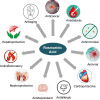Biomedical features and therapeutic potential of rosmarinic acid
- PMID: 35391712
- PMCID: PMC8989115
- DOI: 10.1007/s12272-022-01378-2
Biomedical features and therapeutic potential of rosmarinic acid
Abstract
For decades, the use of secondary metabolites of various herbs has been an attractive strategy in combating human diseases. Rosmarinic acid (RA) is a bioactive phenolic compound commonly found in plants of Lamiaceae and Boraginaceae families. RA is biosynthesized using amino acids tyrosine and phenylalanine via enzyme-catalyzed reactions. However, the chemical synthesis of RA involves an esterification reaction between caffeic acid and 3,4-dihydroxy phenyl lactic acid contributing two phenolic rings to the structure of RA. Several studies have ascertained multiple therapeutic benefits of RA in various diseases, including cancer, diabetes, inflammatory disorders, neurodegenerative disorders, and liver diseases. Many previous scientific papers indicate that RA can be used as an anti-plasmodic, anti-viral and anti-bacterial drug. In addition, due to its high anti-oxidant capacity, this natural polyphenol has recently gained attention for its possible application as a nutraceutical compound in the food industry. Here we provide state-of-the-art, flexible therapeutic potential and biomedical features of RA, its implications and multiple uses. Along with various valuable applications in safeguarding human health, this review further summarizes the therapeutic advantages of RA in various human diseases, including cancer, diabetes, neurodegenerative diseases. Furthermore, the challenges associated with the clinical applicability of RA have also been discussed.
Keywords: Anti-cancer therapy; Bioactive phenolic compounds; Drug discovery; Natural products; Rosmarinic acid.
© 2022. The Pharmaceutical Society of Korea.
Conflict of interest statement
The authors declare no conflict of interest.
Figures
References
-
- Ahmed AS, Mona MM, Abdel-Kareem MA, Elsisy RA. Potential of rosmarinic acid to ameliorate toxic effects of diethyl methoxy thio-phosphoryl thio-succinate on albino wistar rats' lung, mast cell infiltration inhibitory pathway. Food Sci Nutr. 2021;9(7):3593–3601. doi: 10.1002/fsn3.2316. - DOI - PMC - PubMed
-
- Alagawany M, Abd El-Hack ME. The effect of rosemary herb as a dietary supplement on performance, egg quality, serum biochemical parameters, and oxidative status in laying hens. J Anim Feed Sci. 2015;24:341–347. doi: 10.22358/jafs/65617/2015. - DOI
Publication types
MeSH terms
Substances
Grants and funding
LinkOut - more resources
Full Text Sources
Other Literature Sources
Medical



